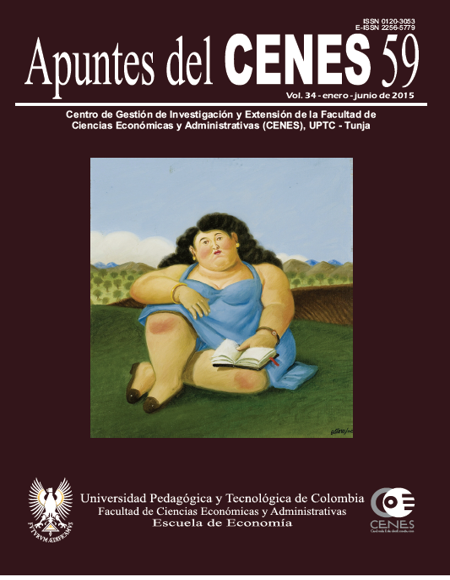The university effect in Valle del Cauca 2009: a multilevel analysis

Abstract
This article examines the university effect on wages of college graduates, i.e., if the university determines the level of income that the professional will receive in the labor market. Data for this research comes from “Survey of the labor market of professionals in the metropolitan area of Cali”, with a sample of 606 students from four universities of the city. Using a multilevel model with three levels (student, program and university) in order to capture effects of common factors groups, this study suggests the existence of a significant and high university effect. These results are consistent with the presence of signals in thelabor markets as proposed by theoryof signaling.
Keywords
University effect, education, labor market, multilevel analysis
References
- Altonji, J. G. &Dunn, T. A. (1995). The effects of school and family characteristics on the return to education. Working paper no. 5072. Cambridge, MA: NBER.
- Amador, M. & López-González, E. (2007). Una aproximación bibliométrica a los modelos multinivel. Relieve, 13(1), 67-82. Recuperado de http:// www.uv.es/RELIEVE/v13n1/RELIEVEv13n1_3.htm
- Arrow, K. J. (1987): “Arrow’s Theorem”, in Eatwell, J., M. Milgate, and P. Newman, eds., The New Palgrave: A Dictionary of Economics, Vol. 1, London: Macmillan, pp.124-126.
- Ashenfelter, O. & Krueger, A. (1994). Estimates of the economic return to schooling from a new sample of twins. The American Economic Review,84(5), 1157-1173.
- Barón, J. (2012). Primeras experiencias laborales de los profesionales colombianos: probabilidad de empleo formal y salarios. Lecturas de Economía, 76, 66.
- Becker, G. (1964). Human capital: a theoretical and empirical analysis, with special reference to education. New York: Columbia University Press.
- Black, D., Smith, J. & Daniel, K. (2005) College quality and wages in the United States. German Economic Review 6 (3), 415-443.
- Bourdieu, P. & Passeron, J. C. (1964). Les Héritiers. Les étudiantset la culture. Paris: Les Éditions de Minuit.
- Card, D. & Krueger, A. B. (1996). Labor market effects of school quality: theory mad evidence. In G. Burtless(ed.). Does money matter? The effect of school resources on student achievement and adult success. Washington, DC: Brookings Institution.
- Casas, A., Gamboa, L. & Piñeros, L. (2002). El efecto escuela en Colombia 1999-2000. Borradores de investigación, 57.
- Castillo, M. (2004). Determinantes de la probabilidad de estar desempleado en el área metropolitana de Cali: evidencias micro y macroeconómicas en el período 1988-1998. Documento de trabajo CIDSE, (73).
- Castillo, M., Escandón, D. & González, O. (2012). Cali, ¿cómo vamos en pobreza? Efectos de zona, comuna y hogar en la percepción de la pobreza,42 (1), 117-138.
- Chevalier, A. & Conlon, G. (2003). Does it pay to attend a prestigious university? IZA Discussion Papers 848. Bonn, Germany: Institute for the Study of Labor IZA.
- Coleman, J.S., Campbell, E.Q., Hobson, C.J., McPartland, J., Mood, A.M., Weinfeld, F.D. & York, R.L. (1966). Equality of educational opportunity.Washington: US Government Printing Office.
- Correa, J. (2004). Determinantes del rendimiento educativo de los estudiantes de secundaria en Cali: un análisis multinivel. Revista Sociedad y Economía (6), 81-105.
- De la Cruz, F. (2005). Modelos multinivel. Revista per. Epidemiol, 12 (3).
- Farné, E. (2006). El mercado de trabajo de los profesionales colombianos. Boletín del Observatorio del Mercado de Trabajo y la Seguridad Social, (9).
- Forero, N. & Ramírez, M. (2007). Determinantes de los ingresos laborales de los graduados universitarios durante el periodo 2001-2004. Serie documentos de trabajo, No. 31. Bogotá: Universidad del Rosario, Facultad de Economía.
- Gamoran, A. & Long, D. (2006). Equality of educational opportunity: a 40-year of retrospective. WCER Working paper No. 2006-9. Recuperado de http://www.wcer.wisc.edu/publications/ workingPapers.
- Hanushek, E. A. (1997). Assessing the effects of school resources on student performance: an update. Educational Evaluation and Policy Analysis, 19, 141-164.
- Hauser, R. M. (1973). Socioeconomic background and differential returns to education.In L. C. Solomon & P. J. Taubman (eds.). Does college matter? Some evidence on the impacts of higher education. New York: Academic Press.
- Holmlund, L. (2009). The effect of college quality on earnings evidence from Sweden. Umea economic studies, (178).
- Hox, J. (2002). Multilevel analisys, techniques and applications. Mahwah, New Yersey: Lawrence Erlbaurn Associates Publishers.
- Hussain, I., McNally, S. &Telhaj, S. (2009). University quality and graduate wages in the UK.
Downloads
Download data is not yet available.